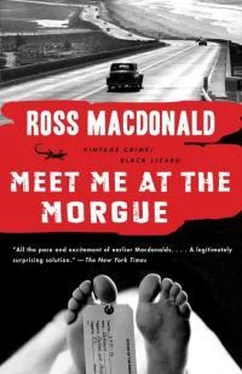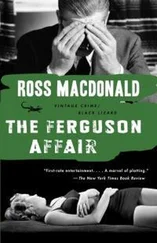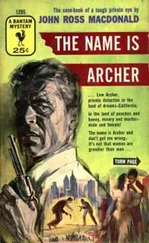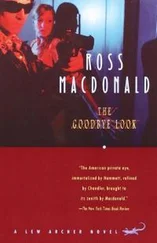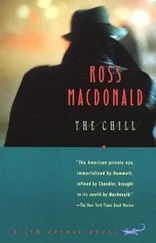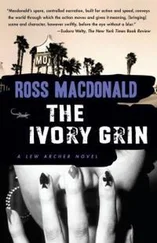Miner’s first drinking episode, he frankly admits, was responsible for the only black mark on his Naval record. Failing to return aboard ship at the assigned time after a weekend pass, he was reduced to the rating of Aviation Motor Machinist’s mate, Second Class. Within a year, however, Miner had recovered his First Class rating, and before his Naval career ended, he achieved the rating of Chief Aviation Motor Machinist.
Miner’s contribution to his country’s defense, a factor to which the community attaches some weight when the kind and degree of a man’s punishment for a crime is in the balance, is sufficiently attested to by the attached letters from Captain Angus Drew, C.O. of the Eureka Bay, 1944–1945; Commander Julius Heckendorf, Executive Officer; and Lieutenant Elmer Morton, First Lieutenant and Damage Control Officer. “His diligence and devotion to duty,” Comdr. Heckendorf writes, “were remarkable even in a branch of the service where such qualities are a normal expectation. His work was an inspiration to the men under him, and a source of satisfaction to his superiors.” During Miner’s service aboard the Eureka Bay, the vessel participated in the Iwo Jima, Luzon, and Okinawa invasions.
Towards the conclusion of the Okinawa campaign, Miner’s Naval career was terminated in what Lieutenant Morton calls “a burst of glory.” The Eureka Bay was struck by a Japanese “suicide” plane, which tore a hole in the flight deck and plunged through to the hangar deck. In the confusion that followed, Miner assumed responsibility for fighting the ensuing fire on the hangar deck, and the crew that he rallied was successful in bringing the blaze under control. Unfortunately, a bomb exploded in the wreckage of the “Kamikaze” throwing Miner against a bulkhead and fracturing his skull and spine. Flown to Guam and ultimately to the Naval Hospital in San Diego, Miner spent the greater part of the next year in a hospital bed. He was released from the service on a fifty-per-cent-disability pension in March 1946.
Immediately upon his release, Miner was offered a position as chauffeur with Mr. Abel Johnson, at that time the head of a San Diego real estate firm. He has been employed by Mr. Johnson since that time and has, to quote his employers words, “served us loyally and efficiently.” Mr. Johnson is willing, if the Court sees fit to grant probation, to continue Miner in his present position and to assume reasonable responsibility for his future good behavior (See memo. #8). Dr. Levinson is of opinion that: “Miner in particular, and the community in general, need have nothing to worry about if he will eschew alcoholic beverages in any and all forms. Apart from his potential alcoholism, a condition which is by no means rare among wounded war veterans in general and men who have lost their mothers at an early age in particular, Miner presents a sound psychological configuration.”
Turning to the circumstances of the accident itself, we find certain mitigating circumstances. One is the fact that Miner admits his guilt, and is sincerely repentant. Another is the fact that he was “on holiday” when the accident occurred. While no excuse can be made for drunken driving as such, the fact is that Miner’s employers were both absent at the time, winter-vacationing at their desert establishment, so that Miner cannot be charged with “drinking on duty.” There is the further fact that, while Miner was found to be legally intoxicated at the time of his arrest, his victim was also under the influence of alcohol. The victim’s blood was found to have an alcoholic content of 157 mg., from which it is arguable that the victim may have been at least partly responsible for the accident. As for the second and perhaps more serious charge against Miner, that of leaving the scene of a fatal accident without reporting it to the proper authorities, Miner himself claims that he was totally unaware of the accident’s occurrence. Supporting his assertion, difficult as it is to believe due to the damage to the automobile and the evidence of violent impact, is Dr. Levinson’s opinion that “a person of Miner’s susceptibility to alcohol, with over 200 mg. of it in his blood, might very conceivably have run over a man without knowing it.”
Miner himself can only be described as a willing and hopeful prospect for probation. There are no other violations in his record, and he says with every appearance of sincerity: “I intend to observe all laws in future. My failure to observe the laws against drunken driving and leaving the scene of an accident are a source of intense remorse to me. All I can say is that liquor was my downfall.” His wife, Amy Wolfe Miner, states: “If ever a man has learned from experience, Fred has learned. I am equally responsible with Fred for letting him buy that bottle. We are both resolved that there will be no more bottles, Fred is a teetotaler from here on in.”
We conclude that with his wife’s support and that of his employers, Frederick A. Miner should be in a good position to rehabilitate himself under the guidance of the Probation Department. Such guidance should include a total ban on the consumption of alcoholic beverages, strict adherence to all laws in both letter and spirit, especially traffic laws, regular interviews with the probation authority, a course of indoctrination at the Alcoholism Center, and such other conditions as the Court may see fit to incorporate in its order.
ALEX S. LINEBARGE
Deputy Probation Officer
I put the report back in its folder and replaced it in the “M” file. Thorough as it was, it failed to answer some of the questions rising in my mind. The question Forest had asked, for instance: Could the involuntary manslaughter have been voluntary homicide? Was there a connection between the first anonymous body and the second, between both and Fred? Most important of all, and most difficult: What sort of a man was Miner?
No human personality peeped out between the lines of Alex Linebarge’s unimaginative prose. To Alex, souls were either black or white. He had decided once and for all that Miner was white, and omitted those touches of tattletale gray that would have given reality to his sketch. There was a sense in which Miner, in spite of the laborious biographical data, was a third unidentified man, another Mr. Nobody.
I picked up the telephone and called the mortuary. Seifel had just left there. He was a fourth.
I heard him taking the steps two at a time, and opened the door. He was breathing hard, like a sprinter who had barely made it to the tape. His eyes had a glassy sheen and his face was loose, as if a heavy block of experience had fallen out of the California sky and struck him a dazing blow.
“You shouldn’t do these things to me,” he said in an unsuccessful attempt at lightness. “That room. That face. I’m a tenderly nurtured boy, I can’t take death in the afternoon.”
“Do you know the man?”
“I believe I do. I think I can say I’m virtually certain I’ve seen him. But lawyers make poor witnesses, you know–”
I interrupted his nervous wordiness: “Sit down and tell me about it.”
“Yes, of course.” His glance moved unsteadily around the dingy walls and rested in the sweet peas on Ann’s desk. They were beginning to fade. “Say, old man, could I have a drink of some kind? My throat is parched.”
I pointed to the cooler. “All we stock is water.”
“Water will be fine. Adam’s ale, my mother calls it.” He filled and drained a paper cup, three times. “How in the world did you know I’d seen that chap?” he said with his back to me.
“That’s beside the point…”
“Was it dear little Annie?”
“We’re wasting time. Now come in here and sit down and talk.” I opened the door of the inner office and motioned him in.
Читать дальше
